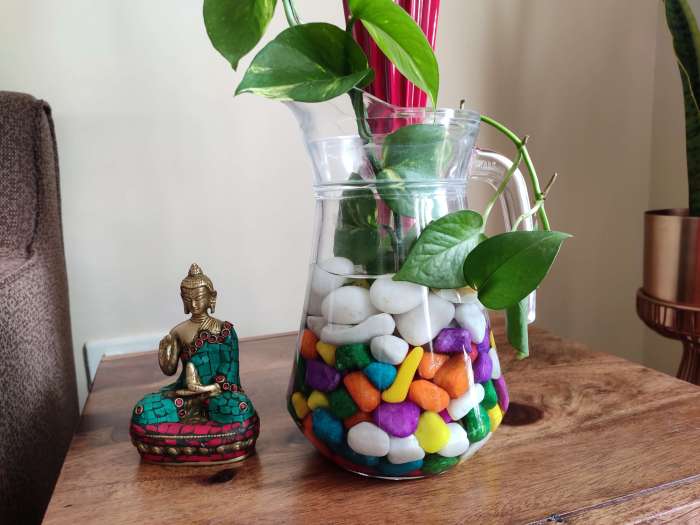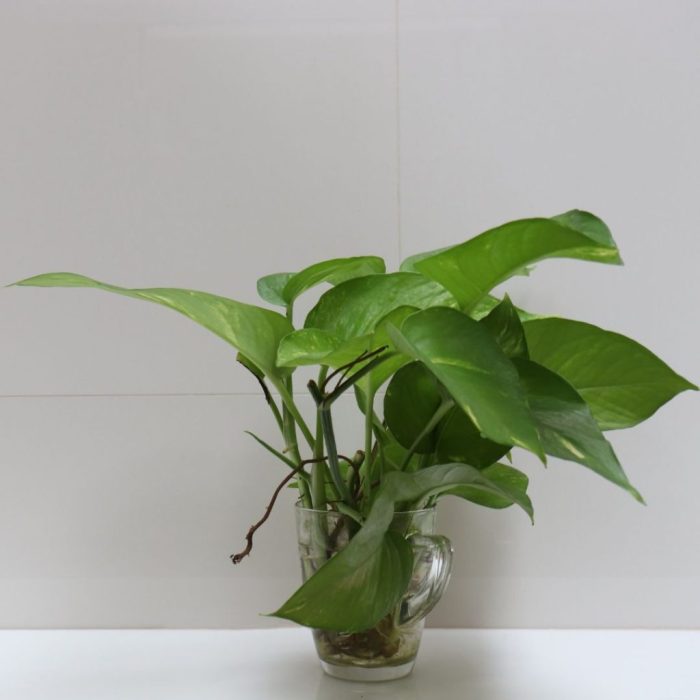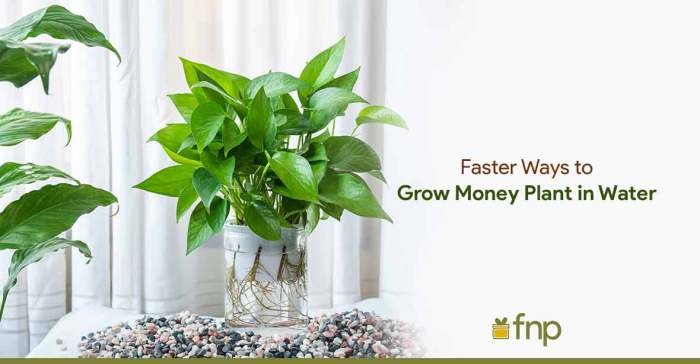How Often to Water Money Plant
Understanding Money Plant Watering Needs
How often to water money plant – Proper watering is crucial for the health and vitality of your money plant ( Epipremnum aureum). The frequency depends on several interacting factors, ensuring you understand these will help you avoid common watering mistakes.
Factors Influencing Watering Frequency
Several environmental and plant-related factors influence how often you need to water your money plant. These include pot size, soil type, the season, and humidity levels.
- Pot Size: Smaller pots dry out faster than larger ones, requiring more frequent watering.
- Soil Type: Well-draining soil, like a potting mix with perlite or coco coir, dries out more quickly than dense, clay-like soil.
- Season: During warmer months, especially summer, the plant transpires more water and requires more frequent watering. In colder months, watering needs decrease significantly.
- Humidity: Higher humidity levels reduce the plant’s need for water, while lower humidity levels increase its need.
Signs of Underwatering and Overwatering
Recognizing the symptoms of both underwatering and overwatering is key to maintaining a healthy money plant. Here’s a comparison:
| Symptom | Underwatering | Overwatering |
|---|---|---|
| Leaf Appearance | Leaves become dry, brittle, and may curl or droop. The color may fade. | Leaves turn yellow, brown, or mushy. They may also droop and fall off. |
| Soil Condition | Soil is completely dry, even several inches below the surface. | Soil remains consistently soggy and waterlogged. You may see standing water in the pot’s saucer. |
| Overall Plant Health | Plant growth slows down or stops entirely. The plant may appear stunted. | Plant growth slows down or stops. The plant may show signs of root rot, including a foul odor emanating from the soil. |
Watering Frequency Guidelines, How often to water money plant
A general guideline for watering frequency is to water when the top inch or two of soil feels dry to the touch. However, this can vary significantly depending on the growing conditions:
- Indoor, Bright Light: May require watering every 7-10 days.
- Indoor, Low Light: May require watering every 10-14 days.
- Outdoor, Shaded: May require watering every 5-7 days.
- Outdoor, Sunny: May require watering every 3-5 days.
Remember, these are just guidelines; always check the soil moisture before watering.
Practical Watering Methods
Several techniques can effectively water your money plant. Each has its own advantages and disadvantages.
Watering Techniques

Source: bytetrails.com
Here are three common watering methods for money plants:
- Top Watering: Pour water directly onto the soil surface until it drains out the drainage holes. This is the most common method.
- Bottom Watering: Place the pot in a tray of water and allow the soil to absorb water from the bottom up. This method is gentler and helps prevent overwatering.
- Soaking: Thoroughly soak the soil until water drains out the drainage holes. This is useful for very dry soil, but avoid doing this too frequently.
Comparison of Watering Methods
Here’s a comparison of the advantages and disadvantages of each method:
| Method | Advantages | Disadvantages |
|---|---|---|
| Top Watering |
|
|
| Bottom Watering |
|
|
| Soaking |
|
|
Checking Soil Moisture
The “finger test” is a reliable way to check soil moisture before watering. Insert your index finger about an inch or two into the soil. If the soil feels dry, it’s time to water. If it feels moist, wait a few days before watering again.
Watering your money plant depends on its environment; generally, allowing the top inch of soil to dry out before watering is a good guideline. Understanding how frequently to water is key, and to understand that, it’s helpful to know precisely how water contributes to a plant’s health; you can learn more about this process by reading how dose water help plants grow.
Ultimately, consistent but not excessive watering will ensure your money plant thrives.
Addressing Specific Watering Issues

Source: shortpixel.ai
Watering frequency needs adjustments based on the plant’s life cycle and other factors.
Watering During Different Growth Stages
Watering needs vary depending on the money plant’s growth stage:
- Propagation: Keep the soil consistently moist but not soggy during propagation to encourage root development.
- Active Growth: Water more frequently during active growth (spring and summer) when the plant is actively producing new leaves.
- Dormancy: Reduce watering frequency during dormancy (fall and winter) as the plant’s growth slows down.
Impact of Water Type
While money plants are generally tolerant, using filtered or rainwater is preferable to tap water, which may contain minerals that can build up in the soil and harm the plant over time.
Common Watering Mistakes
Here are some common mistakes and how to correct them:
- Overwatering: Allow the soil to dry out between waterings. Improve drainage by repotting in well-draining soil.
- Underwatering: Water thoroughly when the top inch of soil is dry. Increase watering frequency during hot, dry periods.
- Inconsistent Watering: Establish a regular watering schedule based on your plant’s needs and environmental conditions.
Maintaining Optimal Growing Conditions
Beyond watering, maintaining appropriate humidity and fertilization is vital for a thriving money plant.
Humidity Levels
Money plants thrive in moderate to high humidity. Here’s how different humidity levels affect them:
| Humidity Level | Effect on Money Plant |
|---|---|
| Low | Leaves may become dry and brittle; the plant may be more susceptible to pests. |
| Medium | Ideal for healthy growth and lush foliage. |
| High | Promotes vigorous growth, but excessive humidity can lead to fungal diseases if combined with poor air circulation. |
Fertilizing Schedule
Fertilize your money plant every 2-4 weeks during the active growing season (spring and summer) using a balanced liquid fertilizer diluted to half strength. Reduce or stop fertilizing during dormancy.
Troubleshooting Tips
Here are some troubleshooting tips for common money plant problems related to watering:
- Yellowing leaves: Check for overwatering or underwatering. Adjust watering frequency accordingly.
- Drooping leaves: This could indicate underwatering, overwatering, or insufficient light. Investigate and address the underlying cause.
- Brown leaf tips: This is often a sign of underwatering or low humidity. Increase watering frequency and consider increasing humidity levels.
Visual Guide to Healthy Money Plants: How Often To Water Money Plant
A healthy, well-watered money plant exhibits vibrant green leaves with a firm texture. The leaves are full and not wilted or drooping. The overall appearance is lush and vigorous. The soil is moist but not waterlogged; it should feel slightly damp to the touch, not soggy or bone dry.
Underwatered Money Plant
An underwatered money plant displays dry, brittle leaves that may curl or droop. The leaves may appear faded or discolored. The soil will be completely dry to the touch, even several inches below the surface.
Overwatered Money Plant

Source: fnp.com
An overwatered money plant shows yellowing, browning, or mushy leaves that may also droop and fall off. The soil will be soggy and waterlogged, possibly with standing water in the pot’s saucer. A foul odor may emanate from the soil, indicating root rot.
Ideal Soil Moisture
The ideal soil moisture for a money plant is evenly moist throughout the pot. The soil should feel slightly damp to the touch, like a wrung-out sponge. It should not be so wet that water drips out when you press it, nor so dry that it crumbles into dust.
Helpful Answers
Can I use tap water for my money plant?
Tap water is generally acceptable, but letting it sit overnight to allow chlorine to dissipate is recommended. Filtered or rainwater is even better.
My money plant’s leaves are drooping. Is it underwatered or overwatered?
Drooping leaves can indicate both. Check the soil; if it’s dry, it’s underwatered. If it’s soggy, it’s likely overwatered. Examine the roots for rot if you suspect overwatering.
How often should I fertilize my money plant?
Fertilize during the growing season (spring and summer) every 2-4 weeks with a balanced liquid fertilizer diluted to half strength.
What is the best soil for a money plant?
A well-draining potting mix is crucial. A mix of peat moss, perlite, and bark chips is ideal.




















